SLOPING OFF...
...Christchurch and District Model Flying Club’s Magazine for April 2023
Living With LiPos by Trevor Hewson
Following some discussion on the club’s Google group, Mike suggested that I should write something on this subject for Sloping Off. So here goes.
Basically, this is an abridged version of the talk by the same name that I have delivered on a couple of occasions. It is based solely on my own experience as a user, not on any specialist knowledge. For this instalment, we’ll look at chargers and charging
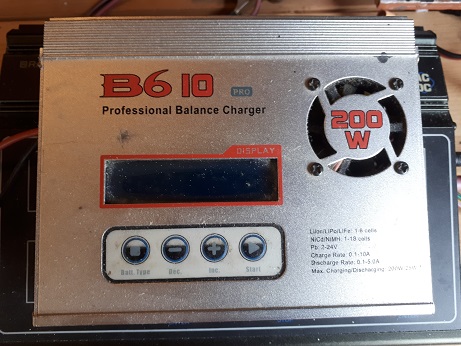
The usual type of charger, uses a 12V source and can charge one battery (or item) at a time
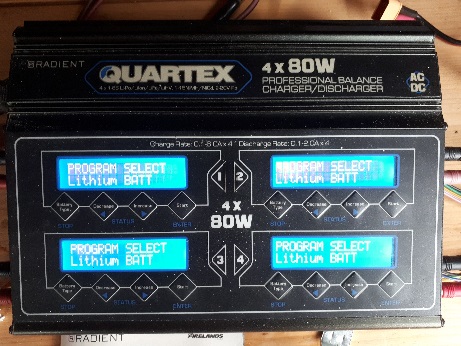
This is the Ed’s charger, bought four years ago. As you can see, it can charge four batteries at a time, or three and a TX, or four different sorts and capacities of battery, etc etc, and runs from mains or 12V. Its charging power per port is of course less than that of the single port charger above. (I think it has been discontinued...Ed)
Chargers
There is a bewildering array of chargers to choose from nowadays and, happily, most of them seem to do the job pretty well. Some things you might like to consider when studying the specifications are:
i) Power Source: Are you looking for a charger that you can plug into the mains or one that you can use at the field, powered perhaps from a 12v lead acid battery? Some chargers can do both but of course you will pay a penalty in terms of weight and also cost. Also bear in mind that the quoted maximum charging power is often only achievable from a D.C. source so you may have to settle for slower charging when using it on the mains.
ii) Maximum cell count and charging power: Many of the cheaper chargers are limited to a charging power of 50w. If you are only using 3s 2200mah batteries this is no problem but even a relatively modest 4s 3000mah battery will run up against the 50w limit. A 6s 5000mah battery (e.g. in a jet) will need a charger that can deliver about 130w to complete a charge at 1c (5amps).
iii) Charge Monitoring: Almost all chargers now enable you to monitor the individual cell voltages during charging. I consider this an essential feature both for battery care and for safety. Many have the option of a temperature probe and can cut off the charge should the battery begin to overheat. Not essential, but well worth having.
iv) EIR Measurement: EIR (Equivalent Internal Resistance) is a good indicator of battery health (more on this in a later instalment) so being able to measure it on your charger is a big plus.
v) Whatever charger you buy, buy a balance board to save wear and tear on the balance connectors on the charger itself.
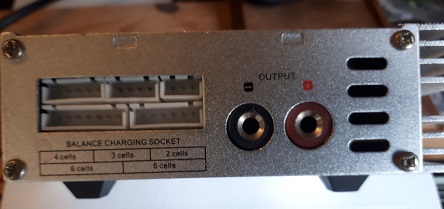
The balance charging sockets on the 200W charger above
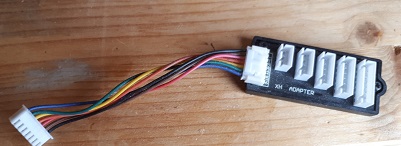
A balance board. It plugs into the 6s socket on the charger
Charging
Okay, so you’ve got your shiny new charger. What now?
i) Read the instructions! You won’t take in everything on a first reading, particularly if the instructions are in the usual ”Chinglish”. However it’s important to know what is in there so that you can refer back to them when the need arises. There may be other unexpected information in there such as the order of making connections. For my elderly iCharger for example, there is a clear recommendation to power up the charger first, then connect the balance plug and only then connect the main wires, preferably positive first, then finally the negative.
ii) Work out a safe charging environment. It’s up to you to assess the risks of charging LiPos in your home. Personally I do, but I utilise a Bat-Safe Box (Google it). As a minimum, make sure the battery is kept away from combustible materials during charging - it’s the time when most LiPo fires happen.
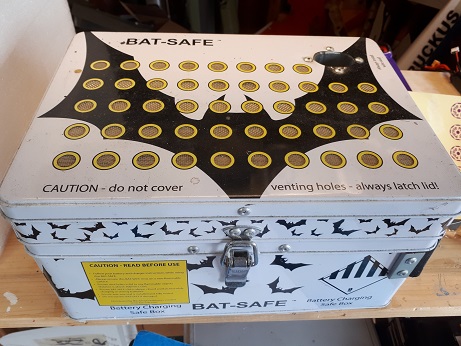
iii) Develop a routine: Every time you charge the battery you should follow a set routine. This might be something like:
- Turn on charger
- Make all connections as above
- Position the temperature probe under the battery
- Select Battery type (e.g. LiPo) and Charging mode (Balance, Fast, Storage etc.)
- Select cell count - although most chargers now do this automatically
- Select charge current - I never use more than 1c, whatever it says on the label (e.g. 2.2a for a 2200mah battery)
- If you can do so, check the EIR readings for the cells. Have they changed significantly from last time? (More on EIR in a later instalment).
- Start charger
- Check that the charger has guessed the cell count correctly - it will normally show 2s or 3s or whatever somewhere on the display
- Check the individual cell voltages - on many chargers pressing the + button during the charge will display the individual cell voltages. If not, it’s time to go back to those instructions! If the cell voltages differ significantly (say, more than .05v) give the balance plug a wobble in case the contacts are poor. If the discrepancy persists, it could be an indication that your battery is in trouble and you should watch it more carefully. Or, if this happens with several batteries, it’s probably time to replace your balance board.
- Ideally stay in the room throughout the charge. If not, at least stay within earshot.
- At the end of the charge look at how much charge went in. This is the mah figure. It might be something like 1200mah if you were re charging a 2200mah battery from a storage condition. Is the reading more or less what you expected?
- Check the cell voltages again. They should all be pretty close to your target end voltage (usually 4.2v)
- If you weren’t able to look at the EIR values earlier, do so now. Have they changed significantly since last time?
- Disconnect the battery and mark it as charged. There are lots of ways to do this - I simply put a rubber band round the battery, which will be removed when the battery is put into the model.
- If the EIR has changed significantly, note this on the battery (again, more on this next time)
That’s probably enough for now. Future instalments are planned to look at “Care and Use” and Storage and Disposal” but if you’d like some other aspect to be covered, let me know and I’ll see what I can do.
TJH March 2023